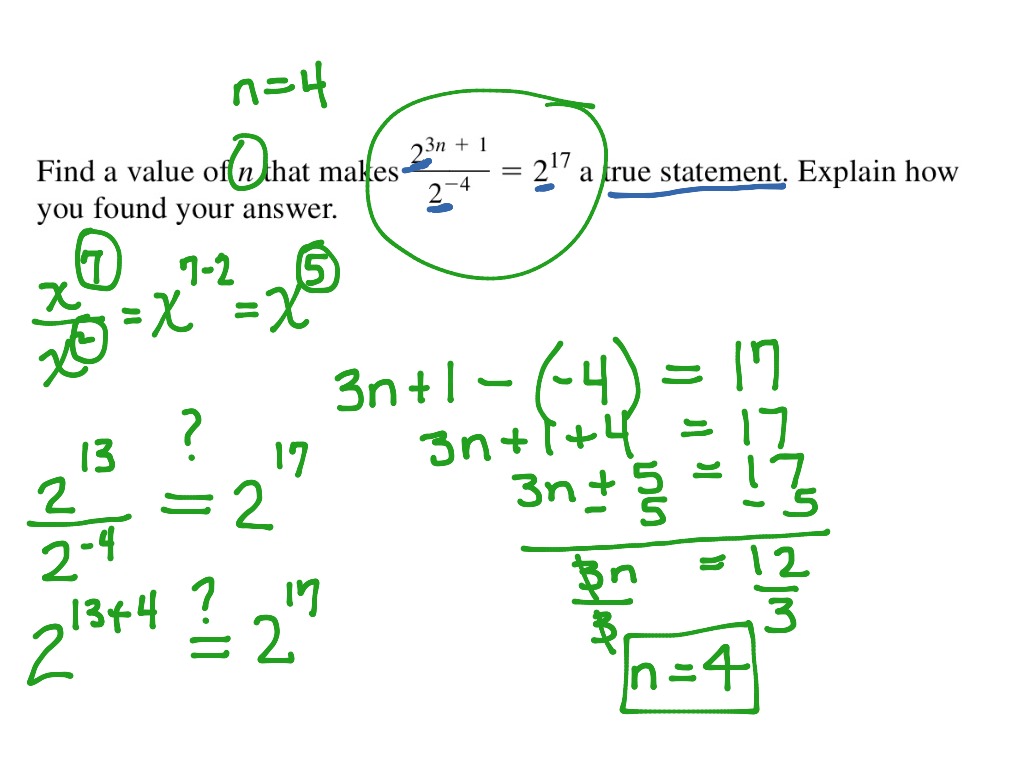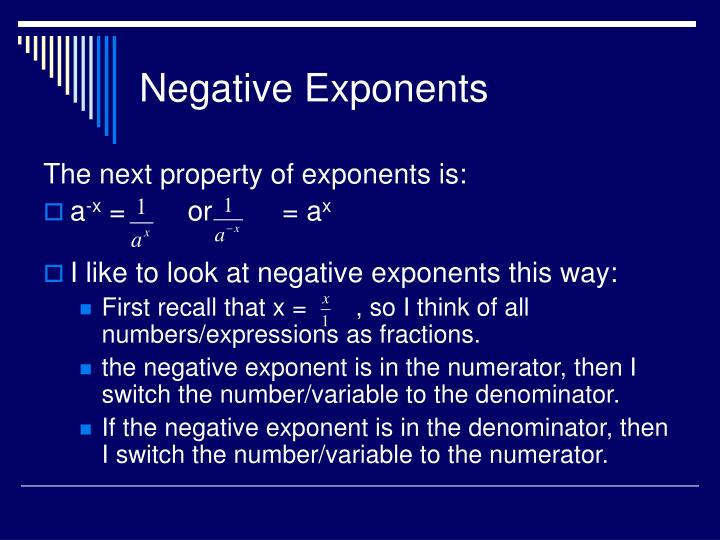

Then solve as usual with the power rule.ĭefinitely not as confusing as it first looked, right? Our first step is just to flip the numerator and denominator to get rid of all the negatives in the exponents. With that in mind, let's work through the question. If you move it to the numerator, its exponent also becomes positive. When we have a fraction with a root in the denominator, like 1/2, its often desirable to manipulate it so the denominator doesnt have roots. The same actually works for negative exponents on the bottom. If you ever see a negative exponent on the top of a fraction, you know that if you flip it to the bottom, it'll become positive.
#NEGATIVE EXPONENTS IN DENOMINATOR HOW TO#
So moving on from the above, we can continue solving with the negative exponent as we did before.Īs you can see, the final answer we get is negative!. 1) If you mean how to handle negative exponents within a fraction, the short answer is: negative exponents in the numerator become positive in the denominator.

However, keeping the -1 outside helps us work with the negative exponent a little easier and allows us to illustrate what's happening. Below you will find eleven topics that include exponents in some way shape and form. To determine the denominator, we make the negative exponent positive. The fraction is made up of a numerator equal to one. If there is something more complex such as then only the x will go to the denominator since it is the one with the negative exponent. Multiplying in that -1 will turn the equation back into what it was originally. This is because a fractional exponent means that the base is on the wrong side of the fraction line (the denominator). so the final answer is To simplify the following: we have to move the x to the denominator and make the exponent positive. One way you can rewrite the question we're given is the following: Again, just move the number to the denominator of a fraction to make the exponent positive. In this case, we've got a negative number with a negative exponent. Then, solving for exponents is easy once we have it in a more calculation-friendly form. This can be summarized in a rule: Negative Power Rule for Exponents: xn 1 xn, where x 0. So negative exponents simply represent fractions with exponents in the denominator. We'll start with regular numbers with a negative exponent, then move on to fractions that have negative exponents on both its numerator and denominator.Īs we learned earlier, if we move the number to the denominator, it'll get rid of the negative in the exponent. Canceling out the factors in the numerator and denominator leaves the leftover factors in the denominator, and subtracting the exponents leaves a negative number. Let's try working with some negative exponent questions to see how we'll move numbers to the top or bottom of a fraction line in order to make the negative exponents positive. You'll soon understand all the basic properties of exponents! How to solve for for negative exponents To Divide Monomials Divide the numerical coefficients. To avoid dividing by zero we make the assumption that all variables represent positive or negativenumbers, but not zero. When a monomial has been simplified all of the exponents will be positive numbers. There'll be a link to a chart at the end of this lesson that can show you how that relationship comes about. All rules that apply to positive exponents also apply to negative exponents. Since d-3 on the bottom has a negative exponent, it is moved to the. Move the base with a negative exponent to the opposite side of the fraction, then make the exponent positive. The top and bottom both contain negative exponents. Learning this lesson will also help you get one step closer to understanding why any number with a 0 in its exponent equals to 1. Any nonzero number raised to a negative exponent is not in standard form. That's the main reason why we can move the exponents around and solve the questions that are to follow. However, you can actually convert any expression into a fraction by putting 1 over the number. You might be wondering about the fraction line, since there isn't one when we just look at x^-3. For example, when you see x^-3, it actually stands for 1/x^3.

In other words, the negative exponent rule tells us that a number with a negative exponent should be put to the denominator, and vice versa. \(\displaystyle\frac\) using only positive exponents and simplify.A negative exponent helps to show that a base is on the denominator side of the fraction line. Version 1: Use the negative exponent rule and then quotient ruleįirst, we apply the negative quotient rule that says as long as all the factors are being multiplied or divided together (no addition or subtraction) then we can move a factor with a negative exponent to the opposite side of a fraction and change the exponent to a positive.


 0 kommentar(er)
0 kommentar(er)
